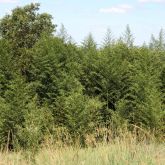Bamboo

Bamboo stem
© Queensland Government

Bamboo infestation
© Queensland Government

Bamboo leaf
© Queensland Government

Bamboo leaves and stem
© Queensland Government

Bamboo plant
© Queensland Government
Native to tropical and subtropical Asia, bamboo is a tall, woody grass that grows in dense stands. Bamboo was introduced to Australia as an ornamental plant, and today is often used to create shelter belts or for erosion control.
Bamboo species have spread into many parts of South East Queensland and northern New South Wales. Where they have broken containment and become invasive, running bamboos have become a problem for landowners and managers of natural areas. Nothing will grow under bamboo, and it crowds out native and other desirable species.
Bamboo is not a prohibited or restricted invasive plant under the Biosecurity Act 2014.
Scientific name
Description
- Tall, perennial, woody grass ranging in height from 2–15m.
- Stems are hollow canes with nodes at intervals.
- Leaves are alternate, thick, grass-like.
- Flowers are held on slender, arching panicles, appear infrequently, usually insignificant.
- Root system is dense mat of fibrous hair roots.
- Shoots develop from buds of underground rhizomes.
Habitat
- Gardens and shelterbelts.
- Edges of bushland (garden escapees).
Distribution
- Occurs in South East Queensland.
Life cycle
- Rarely flowers.
Impacts
Environmental
- Excludes other vegetation in many different environments.
How it is spread
- Spread mostly by underground rhizomes and dumped garden waste.
Prevention
Control
Physical control
- Digging plants out can be difficult.
- Ongoing regular cutting or mowing will eventually destroy most plants.
- To contain garden plantings, install a root barrier in the ground around the bamboo with the top edge extending a couple of inches above ground. (Bamboo rhizomes sometimes emerge from the ground and dive down again. If the barrier extends above ground, it's easy to see rhizomes and cut them back.)
- Take care to ensure your own and others safety when trimming or lopping bamboo near power lines.
Mechanical control
- On flat ground, use an excavator, backhoe etc. to dig up rhizomes and remove dense stands quickly. Rhizome depth varies depending on species but digging is usually required to around 1m depth.
Herbicide control
- Various formulations containing glyphosate as their only active ingredient are registered for control of bamboo.
See the Bamboo fact sheet (PDF, 3.9MB) for herbicide control and application rates.
Legal requirements
- Bamboo is not a prohibited or restricted invasive plant under the Biosecurity Act 2014. However, by law, everyone has a general biosecurity obligation (GBO) to take reasonable and practical steps to minimise the risks associated with invasive plants under their control.
- Local governments must have a biosecurity plan that covers invasive plants in their area. This plan may include actions to be taken on Bamboo. Some of these actions may be required under local laws. Contact your local government for more information.